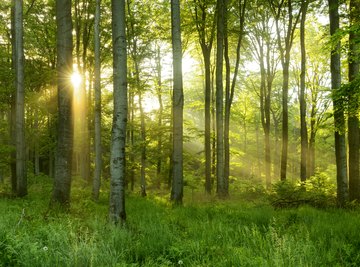
The Paleozoic era began around 542 million years ago with a massive explosion of life forms. It ended 291 million years later with the extinction of between 90 and 95 percent of life on the planet. Its climate was marked by massive temperature fluctuations as continental masses shifted around the Earth’s surface. Continents broke apart, fracturing the Earth’s crust, and crashed together again, closing off seas and creating mountains. Volcanic activity changed the chemistry of the atmosphere. The Paleozoic is divided into six periods: Cambrian, Ordovician, Silurian, Devonian, Carboniferous and Permian.
Continental Masses
The ancient supercontinent of Rodinia, which formed a billion years ago and as a single land mass on the Earth, had broken up by the beginning of the Paleozoic into six main parts. These masses reassembled over the Paleozoic era to create a new supercontinent, Pangaea. As the land masses collided, they closed off the seas leaving a single ocean, which scientists call Panthalassa.
Cambrian and Ordovician
Life exploded 542 million years ago at the beginning of the Cambrian period when land masses were positioned around the center and temperate regions of the globe. Oceans flooded and eroded the land. Sediments deposited in the oceans increased oxygen levels in the water. Temperatures rose to the beginning of the Ordovician period 488 million years ago and the first land plants appeared. Continents tore apart, rifting the ocean floor and causing a large amount of volcanic activity. As land masses headed toward the Earth’s polar regions, ice ages began, temperatures fell planet-wide and one-third of life on Earth became extinct.
Silurian
Life rebounded with the start of the Silurian period 443.7 million years ago. Coral reefs and fish appeared in warm, shallow seas. Temperatures rose, creating distinct climatic zones. A continental mass in the southern hemisphere had a polar ice cap that merged northward into a temperate zone and arid land conditions around the equator. The warm seas deposited salts in coastal regions, encouraging marine plants and animals to adapt to life on land.
Devonian
When the Devonian period began 416 million years ago, there were just two land masses, both located near the equator. Temperatures warmed, wetlands became drier, and trees grew on land, while a great variety of fishes developed in the seas. Toward the end of the period 359 million years ago, ice built up over the southern polar region, causing sea levels to fall, followed by the extinction of nearly 70 percent of marine life. At the same time, temperatures in the northern hemisphere were rising.
Carboniferous and Permian
The Carboniferous period saw climate changing in the northern hemisphere from hot desert to wet and humid conditions. Lush plants and trees grew in swamps and flood plains. At the start of the Permian period 299 million years ago, two major continental masses moved closer, the seas between them closed, marine habitats decreased, and the climate became dry. Continental collisions formed mountains like the Appalachians and the Urals. Volcanoes spewed ash into the atmosphere, blocking sunlight and making temperatures and atmospheric oxygen levels fall. The sea became toxic as methane and carbon dioxide trapped in marine sediments was released. By 251 million years ago, the Earth’s ozone layer was destroyed and 90 to 95 percent of life was extinct.
References
About the Author
Based in London, Maria Kielmas worked in earthquake engineering and international petroleum exploration before entering journalism in 1986. She has written for the "Financial Times," "Barron's," "Christian Science Monitor," and "Rheinischer Merkur" as well as specialist publications on the energy and financial industries and the European, Middle Eastern, African, Asian and Latin American regions. She has a Bachelor of Science in physics and geology from Manchester University and a Master of Science in marine geotechnics from the University of Wales School of Ocean Sciences.
